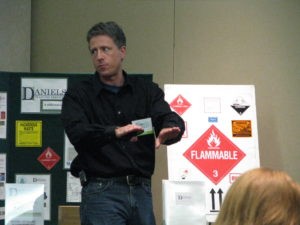Federal regulations of the U.S. Environmental Protection Agency (USEPA) at 40 CFR 262.17(a)(6) require a large quantity generator of hazardous waste (LQG) to comply with the preparedness, prevention, and emergency procedure standards of 40 CFR 262, subpart M. This article is the first in a series that looks closely at each of the sections in subpart M to clearly describe the responsibilities of a LQG.
The purpose of this article is to address the requirements of 40 CFR 262.250 Applicability (of the preparedness, prevention, and emergency procedures for large quantity generators).
Before we begin…
These regulations were revised by the Generator Improvements Rule. If your state has not yet adopted the new rule you must continue to comply with the earlier version until it does. You may read an article explaining the earlier version of the regulations (prior to implementation of the Generator Improvements Rule) here.
Scope and Applicability:
These regulations are applicable solely to a LQG – as clearly stated below. The preparedness, prevention, and emergency response regulations for a small quantity generator of hazardous waste (SQG) are similar but lack this clear statement of applicability. The reason for that is the comparable regulations for a SQG are located entirely within §262.16 Conditions for exemption for a small quantity generator that accumulates hazardous waste. For that reason it is unnecessary to include a section on applicability for a SQG.
|
Not sure of your hazardous waste generator status? |
40 CFR 262.250 reads:
The regulations of this subpart apply to those ares of a large quantity generator where hazardous waste is generated or accumulated on site.
Why the change?
USEPA felt current preparedness, prevention, and emergency procedures regulations did not clearly state if they were applicable to the entire facility or only to areas of the LQG where hazardous waste are generated, accumulated, where allowable treatment may occur, and when transported off site for subsequent treatment, storage, or disposal. USEPA acknowledged that previous Agency guidance indicated RCRA preparedness and emergency procedures regulations, including development of contingency plans by LQGs, would only apply to 90-day accumulation units; now known as central accumulation areas, or CAAs. The purpose of the change in regulation was to remove this confusion.
|
Interested in site specific training at your site that covers this topic, and more! Ask me about my Onsite Training |
What then are the areas of a LQG subject to these regulations?
The following areas – and only these, not the entire facility – of a large quantity generator of hazardous waste are subject to the new (from the Generator Improvements Rule) regulations of 40 CFR 262, subpart M – Preparedness, Prevention, and Emergency Procedures for Large Quantity Generators:
- Any point of generation of a hazardous waste.
- Areas where hazardous waste is accumulated subject to full regulation: central accumulation areas or CAAs.
- Areas where hazardous waste is accumulated subject to reduced regulation: satellite accumulation areas or SAAs. To clarify the applicability of these regulations to SAAs, §262.15(a)(8) within the satellite accumulation area regulations reads: All satellite accumulation areas operated by a large quantity generator must meet the Preparedness, Prevention and Emergency procedures in subpart M of this part.
- Areas where allowable treatment may occur in accumulation units. USEPA believes that locations of such treatment would be covered as part of the overall accumulation and management process within a facility.
And…
EPA is, therefore, finalizing regulations making it clear that points of generation and SAAs, in addition to CAAs, fall within the scope of regulations for preparedness and planning in 262.16(b)(8) for SQGs and 40 CFR part 262 subpart M for LQGs. (FR vol 81, No. 228, 11.28.16 / 85792)
|
Contact me with any questions you may have about the generation, identification, management, and disposal of hazardous waste Daniels Training Services, Inc. 815.821.1550 |
Is that it?
No. First of all, as a LQG you must still comply with the remaining requirements of §262, subpart M as they were revised by the Generator Improvements Rule.
And then, what about training? At §262.17(b)(7) – directly following the referral to emergency procedures – are the training requirements for a LQG. §262.17(b)(7)(i)(C) reads in part:
At a minimum, the training program must be designed to ensure that facility personnel are able to respond effectively to emergencies…
So clearly, Hazardous Waste Personnel Training at a LQG is important.


